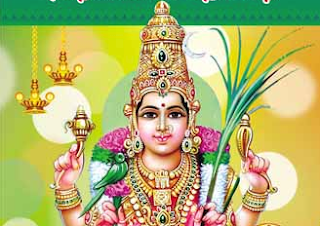Thus Spake the Divine - Jnyanambika (Goddess of Wisdom)
Thus Spake the Divine
Jnyanambika (Goddess of Wisdom)
Ambal, apart from protecting this Universe as its Mother, is also a Guru. In this chapter, Maha Periyava quotes a story from Kenopanishad in which Ambal, as Jnyanambika, imparts wisdom to Devas. Periyava associates this story with Kalahasthi, a pilgrimage centre in Andhra Pradesh with a Shiva Temple.
Sri Vidya is a special form of worshipping Ambal. Vidya means knowledge. Avidya means ignorance. Ambal, as the Mother of Universe, nourishes Her children not only with milk and food, but also with awareness and knowledge. Here, She takes the role of a Guru (Teacher) too. It is She who imparts knowledge to Devas, says a story in Kenopanishad in Sama Veda.
Here goes the story.
Long, long ago, there was a battle between Devas and Asuras. Devas won the battle. They became very proud of their victory. They forgot that they had fought the battle only with the Anugraha of Paramatma. They thought they became victorious because of their own power and strength. They started celebrating their victory flamboyantly.
Paramatma was worried that with such an attitude, Devas were likely to absorb the loathsome traits of Asuras, like being egocentric. Therefore, to protect them from their ego and self-pride, Paramatma masqueraded as a ball of fire with His head and feet invisible. Devas saw this image and wondered what kind of an image was that. Any incomprehensible substance is called Yaksham. They wanted to know who the Yaksham was. They sent Agni, God of Fire, to find out the same.
Before Agni could ask who the Yaksham was, Yaksham asked him, “Who are you?” Agni said, “I am Fire God. I am also called Jatha Vedas”. Yaksham asked him what his special power was. Agni answered, “I can burn anything into ashes”. In response, Yaksham put a tiny iron particle (thurumbu in Tamil) in front of Agni and asked him to burn it. Agni applied all his strength on the iron particle, but it did not burn. Agni was ashamed of his failure and returned to Devas. He narrated what happened.
Devas were upset that the powerful Agni had been unable to know who the Yaksham was. Now, they sent Vayu, God of Air. As before, Yaksham advanced this question, “Who are you?” Vayu answered, “I am Vayu and I am also known as Matarishvan. I possess great valour and power of lifting anything”. Yaksham showed the iron particle and asked Vayu to lift it. Vayu put all his efforts, yet he could not lift it. Vayu returned with shame. The King of Devas, Indra, realised that this Yaksham was far superior and powerful than all Devas. Wisdom dawned on him and his ego and pride melted; humility and Bhakti crept into him for a moment.
(Maha Periyava adds: We keep celebrating our victories as though we have achieved something great. This has become a fashion nowadays. After some time, this victory is lost and some other people celebrate their victory. This goes on and on. Eternal victory is only self-victory (Atma Jayam), which is self-realisation. Atma Jayam as well as all other worldly victories are bestowed only by Ambal’s Anugraha.
Indra then went near that Yaksham with utmost humility. Now, Yaksham stood in the divine womanly form of Ambal and imparted wisdom to Indra. This sight is described in Kenopanishad as “The effulgence of Uma Devi is seen sparkling in the sky”. Indra immediately prostrated before Ambal, the Light of Wisdom. He politely asked, “Who was the Yaksham standing here before?” Ambal, in the form of Guru, said, “Oh Indra! That Yaksham was Brahmam Himself! Brahmam is the origin or foundation of everything in this Universe, including you, Devas and Asuras. That Supreme Power is present among all life forms in bits and pieces”.
First, in the form of Yaksham, She deflated the ego and pride of Devas. Once done, She became Guru and imparted Jnyana to Indra.
It was King of Devas (Devaraja), who could recognise the reality of Yaksham’s supreme power and Devas’ limitations. Thus he got his name Indra (Idam + Tra). While all other Devas had just seen the image of Brahmam in the form of Yaksham, it was only Indra, who could get the Dharshan of compassion-filled Ambal and revelation of Brahma Rahasya (Secret of Brahmam) as well in the form of preaching.
In the Bhashyam of Kenopanishad by Bhagavadpada, where he describes Ambal as “Highly Effulgent” (Bahu Shobamana), he says, “The highest effulgence above all is the effulgence of wisdom (Vidya). The very Vidya Persona is Ambal. She turns into Haimavati and emanates effulgence. Parameshvara is Sarvagna, who knows everything, and Ambal is Jnyana Swaroopini, who is completely unified with Brahmam. She is the Power of Brahmam, the only substance, which is Itself the Knower, Subject and Knowledge.” When I talked about Yaksham with its head and feet unknown, it might appear as though there is a link between this and that of Tiruvannamalai, where Brahma and Vishnu entered into a contest to find the head and feet of Lord Shiva. This story is linked to Sri Kalahasthi, a sacred place in Andhra Pradesh.
Once, I visited Kalahasthi and went around the mountain (Giri Pradhakshinam). On the way, I climbed up a hill and had the Dharshan of Shiva Lingam. It is a Sahasra Lingam in which a thousand tiny lingams are sculpted within. In that temple, there is a lingam, which people call “Yaksha Lingam”. There is also one Indra Lingam. The name of Ambal in Kalahasthi temple is Jnyana Prasoonnambika. Prasoonam in Sanskrit means flower. If you link all these, you can conclude that the incident narrated in Kenopanishad, viz. Yaksham’s appearance and Ambal’s preaching to Indra, would have occurred only in Kalahasthi.
We don’t need to explore new ways of worshipping Ambal. There are sacred temples like Kalahasthi, where Sages and Saints have worshiped Her. If we visit such temples and meditate on Her, we will definitely get Her grace.
Like a flower and its fragrance, milk and its palatability, and fire and its radiance, Ambal is the power of wisdom, inseparable from Parameshvara. In the form of Narayana’s sister, She is similarly inseparable from Narayana. When She killed Asuras in the form of Durga, She was known as Vaishnavi. When Sri Krishna was born, Durga emerged from the womb of Yashoda as Vishnu Maya. We worship Durga, the Destroyer of Evils, during Navaratri, which occurs during the autumn season (Sharad Ritu).
After Navaratri, we celebrate another Navaratri, which falls in spring (Vasanta Ritu). During this Navaratri, Ambal emerges as the Wisdom Persona. As Durga emerges as Vishnu Maya when Krishna is born, Ambal appears as Jnyanambika when Rama is born. This Navaratri is known as Vasanta Navaratri. The very Durga we worship in a furious and aggressive form during Sharad Ritu Navaratri, is in Her most pleasant form in Vasanta Ritu Navaratri.
I have told that Uma is Pranava Swaroopam. Music is Her body. Ambal’s body, in addition to being filled with music, also haswords. All 51 letters make Her body and it is fully filled with knowledge. That knowledge form is what we call Jnyanambika.
Truly knowledgeable is one, who realises that “True substance remains eternal and unchanged forever; neither it changes nor is it subject to destruction; I am no distinct from that One Substance”. Para Shakti is one who bestows this wisdom on all of us. Let us pray to Her every day and receive Her grace.
This article is a snippet from the Book Thus Spake the Divine, is available online at www.giri.in and across Giri Trading Agency Private Limited, A chain of Speciality Stores dealing in all kinds of products needed in Indian Culture and Tradition.
GIRI is Also the Humble Recipient of "The BEST TOURIST FRIENDLY SHOPPING CENTER in Tamil Nadu" Award For The Year 2019.







No comments